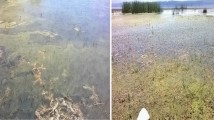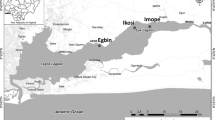Abstract
The purpose of this research was to analyze the underlying mechanisms and contributing factors related to the seasonal dynamic of harmful algal blooms in a shallow eutrophic pond, Bangladesh during September 2005–July 2006. Two conspicuous events were noted simultaneously throughout the study period: high concentration of phosphate–phosphorus (>3.03; SD 1.29 mg l − 1) and permanent cyanobacterial blooms {>3,981.88 × 103 cells l − 1 (SD 508.73)}. Cyanobacterial blooms were characterized by three abundance phases, each of which was associated with different ecological processes. High nitrate–nitrogen (>2.35; SD 0.83 mg l − 1), for example, was associated with high cyanobacterial abundance, while low nitrate–nitrogen (0.36; SD 0.2 mg l − 1) was recorded during moderate abundance phase. Extremely low NO3–N/PO4–P ratio (>3.55, SD 2.31) was recorded, and all blooming taxa were negatively correlated with this ratio. Cyanobacterial blooms were positively correlated with temperature (r = 0.345) and pH (0.833; p = 0.05) and negatively correlated with transparency (r = − 0.956; p = 0.01). Although Anabaena showed similar relationship with water quality parameters as cyanobacteria, the co-dominant Microcystis exhibited negative relationship with temperature (r = − 0.386) and nitrate–nitrogen (r = − 0.172). This was attributed to excessive growth of Anabaena that suppressed Microcystis’s growth. Planktothrix was the third most dominant taxa, while Euglena was regarded as opportunistic.
Similar content being viewed by others
References
Affan, A., Jewel, S. A., Haque, M., Khan, S., & Lee, J. (2005). Seasonal cycle of phytoplankton in aquaculture ponds in Bangladesh. Algae, 20(1), 43–52.
Affan, A., Khan, S., Imokawa, M., & Ueno, Y. (2001). Determination of microcystins in natural waters of Bangladesh by ELISA. In 6th Asian fisheries forum book of abstracts (124 p.).
Ahmed, M. S. (2009). Isolation and characterization of microcystins (Heptapeptides Hepatotoxins) from Microcystis aeruginosa bloom in a homestead pond, Dhaka, Bangladesh. Research Journal of Environmental Sciences, 3(2), 245–250.
Ahmed, M. A., Hiller, S., & Luckas, B. (2007). Microcystis aeruginosa bloom and the occurrence of microcystins (Heptapeptieds Hepatotoxins) from an aquaculture pond in Gazipur, Bangladesh. Turkish Journal of Fisheries and Aquatic Sciences, 8, 37–41.
Alam, A., Mustafa, M. G., & Azad, M. A. K. (2007). Water and sediment quality and plankton diversity of Posna beel, Tangail. Bangladesh Journal of Fisheries, 30(Special Issue), 177–188.
Azadi, M. A. (1987). Limnology of the Kaptai reservior physical-chemical aspects (of Bangladesh). In Proceeding of the 12th annual Bangladesh science conference (pp. 44–45). Dhaka: Bangladesh Association for the Advancement of Science.
Bachmann, R. W., Cloern, J. E., Heckey, R. E., et al. (Eds.) (2006). Eutrophication of freshwater and marine ecosystem. Limnology and Oceanography, 51, 351–800.
Bellinger, E. G. (1992). A key to common algae: Freshwater, estuarine and some coastal species (p. 138). London, UK: The Institute of Water and Environmental Management.
Blomqvist, P., Pettersson, A., & Hyenstrand, A. (1994). Ammonium nitrogen: A key regulatory factor causing dominance of non-nitrogen-fixing cyanobacteria in aquatic systems. Archiv für Hydrobiologie, 132, 141–164.
Brookes, J., & Ganf, G. G. (2001). Variations in the buoyancy response of Microcystis aeruginosa to nitrogen, phosphorus and light. Journal of Plankton Research, 23(12), 1399–1411.
Carpenter, S. R. (2005). Eutrophication of aquatic ecosystems: Distability of soil phosphorus. The National Academy of Sciences of the USA. www.pnas.org/cgi/doi/10.1073/pnas.0503959102.
Chowdhury, A. H., & Mamun, A. A. (2006). Physio-chemical conditions and plankton population of two fishponds in Khulna. University Journal of Zoology, Rajshahi University, 25, 41–44.
Chu, Z., Jin, X., Yang, B., & Zeng, Q. (2007). Buoyancy regulation of Microcystis flos-aquae during phosphorus-limited and nitrogen-limited growth. Journal of Plankton Research, 29(9), 739–745. doi:10.1093/plankt/fbm054.
Deacon, C., & Walsby, A. E. (1990). Gas vesicle formation in the dark, and in the light of different irradiance, by the cyanobacterium Microcystis sp. British Phycological Journal, 25, 133–139.
Dokulil, M. T., & Teubner, K. (2000). Cyanobacterial dominance in lakes. Hydrobiologia, 438, 1–12. doi:10.1023/A:1004155810302.
Ferdoushi, Z., Haque, F., Khan, S., & Haque, M. (2008). The effects of two aquatic floating macrophytes (Lemna and Azolla) as biofilters of nitrogen and phosphate in fish ponds. Turkish Journal of Fisheries and Aquatic Sciences, 8, 253–258.
GEOHAB (2006). In P. Glibert (Ed.), Global ecology and oceanography of harmful algal blooms, harmful algal blooms in eutrophic systems (p. 74). Paris: IOC. http://www.geohab.info.
Hyenstrand, P., Blomqvist, P., & Petterson, A. (1998). Factors determining cyanobacterial succession in aquatic systems- A literature review. Archiv für Hydrobiologie. Special Issues, Advances in Limnology, 51, 41–62.
Islam, P. M., Hussain, M. D., & Alim, R. (2007). Present status of wastewater utilization in Bangladesh: A case study in Mymensingh periurban area. Aqriculture Tropica et Subtropica, 40(2), 65–70.
Islam, M. S., Mahmuda, S., Morshed, M. G., Bakht, H. B. M., Khan, M. N. H., Sack, R. B., et al. (2004). Role of cyanobacteria in the persistence of Vibrio cholerae 0139 in saline microcosms. Canadian Journal of Microbiology, 50(2), 127–131.
Jewel, M. A. S., Affan, M. A., & Khan, S. (2003). Fish mortality due to cyanobacterial bloom in an aquaculture pond in Bangladesh. Pakistan Journal of Biological Sciences, 6(2), 1046–1050.
Jørgensen, B. B., & Richardson, K. (Eds.) (1996). Eutrophication in coastal marine ecosystems. In Coastal and estuarine studies 52. Washington, DC: American Geophysical Union.
Khan, M. A. I., Hossain, A. M. M. M., Huda, M. E., Islam, M. S. & Elahi, S. F. (2007). Physico-chemical and biological aspects of monsoon waters of Ashulia for economic and aesthetic applications: Preliminary studies. Bangladesh Journal of Science and Industrial Research, 42(4), 377–396.
Klemer, A. R. (1982). Cyanobacterial blooms: Carbon and nitrogen limitation have opposite effects on the buoyancy of Oscillatoria. Science, 215(4540), 1629–1631. doi:10.1126/sciene.215.4540.1629.
Klemer, A. R. (1996). Cyanobacterial buoyancy regulation: The paradoxical role of carbon. Journal of Phycology, 32(1), 47–53. doi:10.1111/j.1529–8817.1996.tb02089.
Kromkamp, J., Heuvel, A. V. D., & Mur, L. R. (1989). Formation of gas vesicles in phosphorus- limited cultures of Microcystis aeruginosa. Journal of General Microbiology, 135(7), 1933–1939.
Lam, C. W. Y., & Silvester, W. B. (1979). Growth interactions among blue-green (Anabaena oscilarioides, Microcystis aeruginosa) and green (Chlorella sp) algae. Hydrobiologia, 63, 135–143.
Lee, G. F., Rast, W., & Jones, R. A. (1978). Eutrophication of water bodies: Insight for an age-old problem. Environmental Science & Technology, 12, 900.
Levine, S. N., & Schindler, D. W. (1999). Influence of nitrogen to phosphorus supply ratios and physicochemical conditions on cyanobacteria and phytoplankton species composition in experimental lakes, Canada. Canadian Journal of Fisheries Aquatic Science, 56, 451–466.
Lind, E. M., & Brock, A. J. (1980). A key to the commoner: Desmids of the English Lake district (p. 123). Cumbria: Freshwater Biological Association.
Muzaffar, S. B., & Ahmed, F. A. (2007). The effects of the flood cycle on the diversity and composition of the phytoplankton community of a seasonal flooded Ramsar wetland in Bangladesh. Wetlands Ecology and Management, 15, 81–93. doi:10.1007/s11273-006-9014-6.
Naz, S., & Najia, S. (2008). Study on the zooplankton of Sona Dighi in Rajshahi, Bangladesh. University Journal of Zoology, Rajshahi University, 27, 07–11.
Nixon, S. W. (1995). Coastal marine eutrophication: A definition, social causes, and future concerns. Ophelia, 41, 199–219.
Nwankwo, D. I. (1995). Euglenoides of some polluted storm-water channels in lagos. Nigeria Tropical Freshwater Biology, 4, 29–39.
Oliver, R. L., & Ganf, G. G. (2000). Freshwater blooms. In B. A. Whitten & M. Potts (Eds.), The ecology of cyanobacteria (pp. 149–194). Netherlands: Kluwer Academic Publishers.
Organization for Economic Co-operation and Development (OECD) (1982). Eutrophication of waters: Monitoring assessment and control. Paris: OECD.
Paerl, H. W. (1996). A comparison of cyanobacterial bloom dynamics in freshwater, estuaries and marine environments. Phycologia, 35(6), 25–35.
Palmer, C. M. (1980). Algae and water pollution: The identification, significance and control of algae in water supplies and in polluted water (p. 92). England: Castle House.
Rahman, M. M. (1999). Effects of species composition on pond ecology and growth of fish in carp-SIS polyculture systems. MS Thesis. Department of Fisheries Management, Bangladesh Agricultural University.
Rahman, S., & Jewel, M. A. S. (2008). Cyanobacterial blooms and water quality in two urban fish ponds. University Journal of Zoology, Rajshahi University, 27, 79–84.
Rahman, M. M., Jewel, M. A. S., Khan, S., & Haque, M. M. (2007a). Study of Euglenophytes bloom of its impact on fish growth in Bangladesh. Algae, 22(3), 185–192.
Rahman, M. Z., Mollah, M. F. A., Wahab, M. A., & Rahman, M. M. (2007b). Effect of distillery and agricultural pollution on some physico-chemical properties of water in three beels of Rangpur. Bangladesh Journal of Fisheries, 30(Special Issue), 65–78.
Reynolds, C. S., & Walshy, A. E. (1975). Water blooms. Biological Reviews, 50, 437–481.
Reynolds, C. S., Oliver, R. L., & Walsby, A. E. (1987). Cyanobacterial dominance: The role of buoyancy regulation in dynamic lake environments. New Zealand Journal of Marine and Freshwater Research, 21, 379–390.
Robarts, R. D., & Zohary, T. (1987). Temperature effects on photosynthetic capacity, respiration and growth rates of bloom-forming cyanobacteria. New Zealand Journal of Marine and Freshwater Research, 21, 391–399.
Scheffer, M. (1998). Ecology of shallow lakes. Dordrecht: Kluwer.
Schindler, D. W. (1977). Evolution of phosphorus limitation in lakes. Science, 195(4275), 260–262. doi:10.1126/science.195.4225.
Schwoerbel, J. (1987). Handbook of limnology (p. 228). England: Ellis Horwood.
Smith, V. H. (1983). Low nitrogen to phosphorus ratios favour dominance by blue-green algae in lake phytoplankton. Science, 221(4611), 669–671. doi:10.1126/science.221.4611.669.
Sommer, U., Gliwicz, Z. M., Lampert, W., & Duncan, A. (1986). The PEG-model of seasonal succession of planktonic events in fresh waters. Archiv für Hydrobiologie, 106, 433–471.
Ståhl-Delbanco, A. (2004). Recruitment from resting stages among bloom-forming cyanobacteria. Ph.D. Thesis. Department of Ecology- Limnology and Marine Ecology, Lund University, Denmark.
Stirling, H. P. (1985). Chemical and biological methods of water analysis for aquaculturists (p. 119). Scotland: Institute of Aquaculture, University of Stirling.
Stockner, J. G., & Cronberg, G. (2000). Picoplankton and other non-bloom forming cyanobacteria in lakes. In B. A. Whintton & M. Potts (Eds.), The ecology of cyanobacteria (pp. 195–231). Dordrecht: Kluwer.
Tilman, D. (1982). Resource competition and community structure. Princeton: Princeton University Press.
Trivedy, R. K., Shrotri, A. C., & Khatavkar, S. D. (1990). Physico-chemical characteristics and phytoplankton of the river Panchganga near Kolhapu, Maharastra. In R. K. Trivedy (Ed.), River pollution in India (pp. 159–178). New Delhi: Ashish.
United Nations Environmental Programme (UNEP) (2001). Global environmental monitoring system/water quality monitoring system, with the data for an additional 29 countries from Prescott-allen, R. The Well being of Nations. Washington, DC: Island.
Vincent, W. F., & Silvester, W. B. (1979). Growth of blue-green algae in the Manukau (New Zealand) oxidation ponds. I. Growth potential of oxidation pond water and comparative optima for blue-green and green algal growth. Water Research, 13, 711–716.
Watanabe, M. F., & Oishi, S. (1985). Effects of environmental factors on toxicity of a cyanobacterium (Microcystis aeruginosa) under culture conditions. Applied and Environmental microbiology, 49(5), 1342–1344.
Welker, M., Khan, S., Haque, M. M., Islam, S., Khan, N. H., Chorus, I., et al. (2005). Microcystins (cyanobacterial toxins) in surface water of rural Bangladesh, pilot study. Journal of Water and Health, 3(4), 325–337. doi:10.2166/wh.2005.009.
Whitford, L. A., & Schumacher, G. J. (1973). A manual of freshwater algae (p. 324). Raleigh: Sparks.
Wood, R. B. (1993). Nusiance blooms of cyanobacteria in tropical fresh-water systems. In M. M. Tilzer & M. Khondker (Eds.), Hypertrophic and polluted freshwater ecosystems: Ecological bases for water resource management. Proceedings of international symposium on limnology, 25–28 November 1991 (pp. 121–135). Dhaka: Department of Botany, University of Dhaka.
World Health Organization (1981). Drinking-water and sanitation, 1981–1990; a way to health (pp. 1–4). Geneva: WHO.
Author information
Authors and Affiliations
Corresponding author
Rights and permissions
About this article
Cite this article
Jahan, R., Khan, S., Haque, M.M. et al. Study of harmful algal blooms in a eutrophic pond, Bangladesh. Environ Monit Assess 170, 7–21 (2010). https://doi.org/10.1007/s10661-009-1210-4
Received:
Accepted:
Published:
Issue Date:
DOI: https://doi.org/10.1007/s10661-009-1210-4




